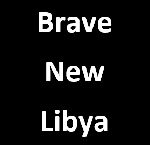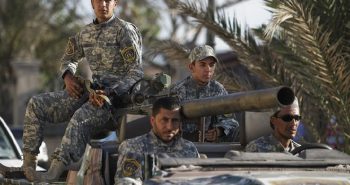Nuruddin Farah

This week’s Eid celebrations in Libya signaled the end of Ramadan, and with it, the close of another season of Ramadan television. Every year, more and more Libyan shows make their way to the small screen, creating an increasingly competitive atmosphere among writers, directors and actors.
The caliber of these shows has gone far and above what Libyans were once used to, with millions of dollars being poured into set designs and costumes, foreign actors and international filming locations. Gone are the days when the only fare on television was ‘Khalti Mashhiya‘ or ‘Hajj Hamad‘, although these still remain popular Ramadan shows for the more nostalgic among us.
One show in particular has captured the hearts of Libyans around the country. ‘Shat Alhurria‘ (شط الحرية) aired its fourth season this year to widespread popularity, attracting not only Libyan viewers but North Africans and Arabs around the region. The show began to gain popularity outside of East Libya by its second season due to its deft use of satire and its political and social commentary on the state of Libyan communities. The name – which translates as ‘The Shore of Freedom’ – is itself a satirical take on the filming location in a semi-desert area, but which also draws on the environmental history of the area.
Part sitcom and part televised theatre, the show centers around the everyday lives of a handful of different tribal members in the semi-fictional town of ‘Maglab Alsharab’. It pokes fun at the stereotype of ‘bedouins’ and offers witty but stinging commentary at the disparity between rural villages and large Libyan cities. Each of the main characters represents an archetypal member of Libyan society, from the strict but caring tribal leader to the wise old shop owner who can recite poetry by heart. Other characters include an ‘Egyptian’ teacher who is the oft-frustrated master of the village’s only school, the local fagih who’s religiosity is a thinly veiled façade and the gang of young men who act as shepherds and frequently get into all sorts of trouble.
Each 30-minute episode is a stand-alone story focusing on one or several of the main characters. Many of the plot drivers revolve around the clash between ‘urban culture’ and the rural lives of the characters, causing amusing mayhem. In one episode, Emraja is perplexed when he finds a discarded take-out coffee cup, a symbol of the foreignness of urban life. Other episodes tackle deeper, age-old issues such as land disputes, family betrayals and father-son relationships. Modern topics are covered as well, like the increasing presence of international organizations in Libya, irregular migration and even psychosocial support.
But it’s the political satire which has made Shat Alhurria’s name. From commentary on the lack of real infrastructure or development projects to the lampooning of corrupt officials, the show doesn’t hold back. Politician-as-dog metaphors are rife, and one episode this season even brought an actor with uncanny resemblance to Abdulhamid Dbaiba, to poke fun at the Prime Minister while also critiquing his role is stoking regional tensions. One particularly poignant episode alluded to the meaningless of the war between East and West Libya – a sensitive military issue that many hesitate to touch. The episode ends on a close up of a white flag flying in the wind over the ‘negotiations’ tent, making a very clear political statement for a show that otherwise focuses on subtle messages.
In another episode, a show dog belonging to an important politician is brought to the village in the hopes that the outdoors would cure the dog’s ‘depression’. The influential dog owner promised electricity, water and even hospitals if they took care of him. The dog lives a more luxurious life than people in the village, one of many metaphors on the inequality between Libyan politicians and the people.
At a time when crackdowns on activists and dissidents have increased across the country, Shat Alhurria continues a tradition of that first began in Benghazi’s theatre scene under the Gadhafi regime. Censorship as a form of self-preservation is an ability that most Libyans grow up learning, but it was through the theatre that many people in Benghazi were able to express their frustration with the state of the country behind the mask of jokes. Plays such as ‘Kowshi Ya Koosha‘ كوشي ياكوشة (which looked at the deteriorating quality of life in Libyan cities), ‘The Hospital‘ المستشفى (a critique of Libya’s failing medical sector) and ‘Kharif ya Sh3aib‘ خرف ياشعيب (a commentary on the failings of the government and society) were incredibly popular and daring for their time, and served as an outlet for these frustrations.
The writer for Shat Alhurria is Fathi Gabsi, a well-known name in the Libyan art world. Most of the actors are part of the Ajdabiya Theatre Troupe, a city in East Libya known for its cultural capital. Almost all of the show’s dialogue is in an East Libyan bedouin dialect (with the exception of Modern Standard Arabic which is thrown in for comedic effect), but this hasn’t prevented people outside the province from enjoying the show. The show came at a time when bedouin culture had become a prime target of propaganda in the online battlefront of Libya’s civil war, when terms like ‘shephard’ have been used in a derogatory way and ‘bedouin’ is used as a shorthand to mean uneducated or uncivilized. The show’s doubling down on the dialect and culture was a deliberate choice to change the narrative.
Of course, with popularity comes all kinds of differing opinions. There has been some criticism of the show, which lambasts the use of bedouin stereotypes and accuses it of pointless mockery. But these critics clearly don’t know or understand how to watch Libyan satire, taking the show at face value without appreciating the intricate level of detail that have gone into the dialogue, storylines or the characters. Rather than mock bedouins, Shat Alhurria sheds a harsh light on the systematic disenfranchisement that rural Libyans have been subjected to for decades.
But even then, the characters of the show are never portrayed in a pitiful light nor are they defined by what they don’t have. They are shown as having a sense of pride in their culture and traditions, even if they occasionally long for the trappings of ‘modern’ life in the city and a better quality of life in their village. The show seems to celebrate the inherent richness of bedouin life despite this marginalization, embedding the rich use of poetry and oral storytelling, the love of music and the boundless hospitality into the storyline. The characters of Shat Alhurria are not one-dimensional clichés but relatable figures that captures much of the Libyan zeitgeist.
To give an example, the character of Mishri is that of a good-natured young man whose story arc focuses on the hijinx he gets up to with his best friend Muwaila and his desire to eventually get married. During one episode where the gang end up in a ‘big city’ to find a tribal member who went missing, Mishri finds himself in front of a bridal boutique and stops his search for a moment to gaze with admiration at the dresses on display. While the running gag for Mishri is that he always talks about his dreams of marriage, this scene transcended the joke for a moment to a give a very real glimpse into the desire and struggle of many young Libyan men to start their own lives.
These kinds of subtle but powerful moments are what Shat Alhurria does best. Of course, it also doesn’t mean that the show doesn’t have weaknesses. The absence of women and a female narrative is glaringly absent from the show, and the treatment of certain social issues (notably one of the main characters who is shown to have learning disabilities) can be quite heavy handed at times. The show’s writers and producers seem to be aware of this criticism and have addressed it somewhat in the later seasons, but there’s still space for further progress. The approach seems to be ‘write what you know’, which in the case of the mostly men cast and crew seems to center on the male experience. However, there is something to be said for the way that the show expertly critiques rigid perceptions of masculinity in Libyan society by highlighting moments of sensitivity and vulnerability among the characters.
Aside from the cultural criticism, Shat Alhurria has also faced political backlash. The Libyan Salafi Movement recently condemned the show, citing ‘7 key reasons’ why it was Islamically inappropriate, although it seems that the main issue was the 7th point, namely that the show mocks those in power. One of the guest writers of the show, activist Mansour Atte from Ajdabiya, was detained for 10 months without a clear charge, leaving many to speculate that one of the episodes he wrote which criticized a politician was the reason for the arrest.
But regardless of the controversies and criticisms, the profound cultural impact that Shat Alhurria has had is undeniable. Online views of the episodes are in the millions, and the show has served as an important source for online Libyan meme culture. It has permeated every level of digital interaction, from WhatsApp sticker albums of the show’s catchlines to reaction GIFs. The fictional locations from the show have even been placed on Google Maps. It’s also clear that the show has made prominent Libyan politicians squirm. While the producers have announced that the fourth season might be the last, the impact that this show on Libya has had will be felt for a long time to come.
__________________




